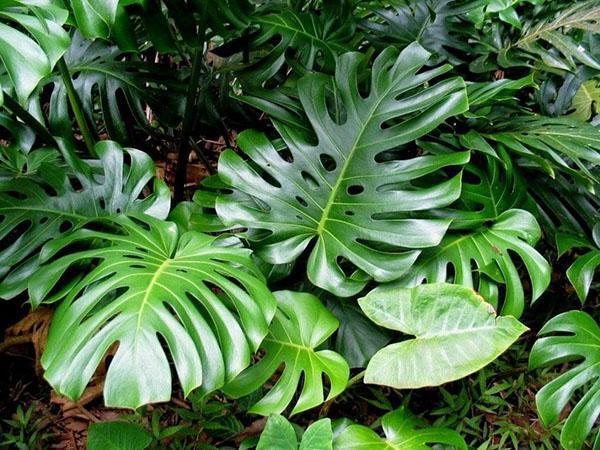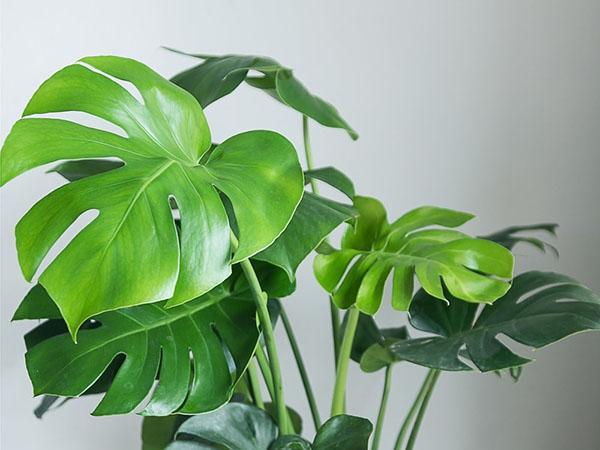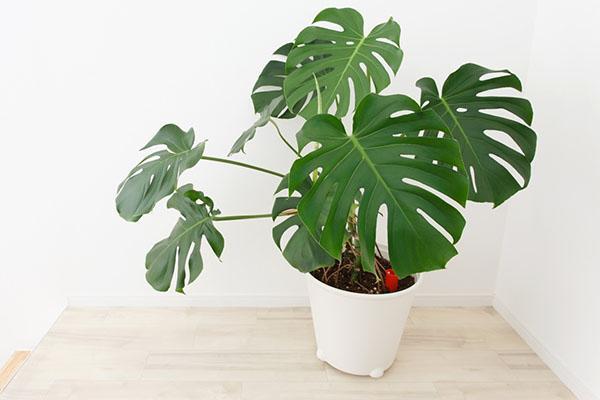How to care for a monster at home
 This large vine is of South American origin; the monstera has taken root well in the tropics of Southeast Asia. When caring for a monster at home is good enough, it reaches several meters in height. An evergreen plant is considered unpretentious, it is not difficult to grow it in an apartment. To do this, it is enough to follow simple rules for caring for a flower. Monstera, leaning on a support, looks very exotic due to large carved leaves and aerial roots. She is able to decorate any interior, to give the room a tropical flavor.
This large vine is of South American origin; the monstera has taken root well in the tropics of Southeast Asia. When caring for a monster at home is good enough, it reaches several meters in height. An evergreen plant is considered unpretentious, it is not difficult to grow it in an apartment. To do this, it is enough to follow simple rules for caring for a flower. Monstera, leaning on a support, looks very exotic due to large carved leaves and aerial roots. She is able to decorate any interior, to give the room a tropical flavor.
The following types of plants are often grown in apartments:
- monstera delicious (attractive);

- oblique monstera;
- punched monstera (full of holes);
- type of monster Borzig;
- monstera Adanson.
Monstera landing
 When a trip to a flower shop ended with the purchase of a young room creeper, the question immediately arises: how to plant a monster correctly? It is clear that its further development and growth rates depend on the flawless planting of the plant. This tropical liana, planted according to all the rules, in an apartment can grow up to 2.5 - 3 m and please with exotic carved leaves from 30 to 50 cm long. This requires two things - a correctly selected substrate and a suitable pot.
When a trip to a flower shop ended with the purchase of a young room creeper, the question immediately arises: how to plant a monster correctly? It is clear that its further development and growth rates depend on the flawless planting of the plant. This tropical liana, planted according to all the rules, in an apartment can grow up to 2.5 - 3 m and please with exotic carved leaves from 30 to 50 cm long. This requires two things - a correctly selected substrate and a suitable pot.
You can use the ready-mix "Palma", it is sold in stores and is suitable for monstera. If desired and available with a component, you can prepare the substrate yourself. For this, it is important to know what the composition of the soil for the monstera should be.
It can be composed of components:
- sand;
- peat;
- leafy land;
- humus;
- turf land.
Moreover, it is necessary to observe the proportion: there is three times more turf land and one part of the remaining components. Then the tropical liana will delight you with large green leaves. Do not forget about good drainage for the plant. Before filling the container with a substrate, a layer of coarse expanded clay 5 cm high should be poured onto the bottom.
It is better to immediately determine which pot to plant the monster in. If the plant is young with a few small leaves, a pot with a capacity of up to 4 liters is fine. It must be heavy and with a pallet. As the flower grows, it will have to be transplanted into a pots with a larger diameter - about 8-10 cm.
Planting a monster without roots will not be a problem. You need to adhere to the usual rules for planting plants. Lay out a layer of substrate on the drainage, place a plant on it and slowly fill the container with soil. It is necessary to immediately thoroughly water the planted vine. The soil should be completely moistened, and water will appear in the pan.
There should be no problem when you need to plant a monster with aerial roots. A moistened twine will come in handy to tie the aerial roots to the trunk of the vine. Over time, small roots will begin to sprout. Then you can cut off a piece of the trunk with leaves and root it.
Caring for a monster at home
 Monstera is an unpretentious flower. But it still requires knowledge of some techniques that help make growing monstera an enjoyable and easy task. Proper watering is vital for this vine. The moisture-loving vine loves abundant watering in all seasons, except for winter, when the flower is sprayed often enough, especially if it is near heating appliances.
Monstera is an unpretentious flower. But it still requires knowledge of some techniques that help make growing monstera an enjoyable and easy task. Proper watering is vital for this vine. The moisture-loving vine loves abundant watering in all seasons, except for winter, when the flower is sprayed often enough, especially if it is near heating appliances.
From warm spring days to late autumn, watering should be frequent and abundant enough, but not excessive. This can harm the root system of the flower, black spots will appear on the leaves. Water for irrigation must be allowed to settle for several days. Liquid at room temperature is used.  Spraying monstera is also important in hot weather.
Spraying monstera is also important in hot weather.
The signal that the monstera needs watering is the drying out of the soil in the pot.
In addition to watering, in caring for a monster at home, such a moment as getting rid of leaves from settled dust is important. This procedure should be performed monthly by gently rubbing the delicate leaves of the plant with a damp, soft sponge.
An adult plant needs mineral feed. Feeding monstera is another essential component of its successful development. Otherwise, the liana will not add in length, throw out new leaves. For feeding, both mineral and organic fertilizers... In the spring and summer season, you need to fertilize the vine twice a month.
With a lack of lighting, the monstera grows slowly, but she does not like the bright sun either. The best option for a flower is diffused lighting and location near windows facing west or east.
The temperature regime of the monstera also needs to be taken care of. The heat-loving liana feels good in summer, when the air warms up to 23-25 ° C, in winter it is comfortable at 17 ° C. Lowering the temperature will immediately slow down the growth of the monstera.
When caring for a vine, you need to protect it from drafts, they are destructive for the monstera.
Bloom
 In wildlife, monstera blooms are a natural thing. The conditions of the apartment are not very suitable for this. Nevertheless, if you study well how to care for a monster, strictly follow all the recommendations for watering and feeding it, from the age of two the liana can give inflorescences. Her flowers are large, white, in the form of an ear.
In wildlife, monstera blooms are a natural thing. The conditions of the apartment are not very suitable for this. Nevertheless, if you study well how to care for a monster, strictly follow all the recommendations for watering and feeding it, from the age of two the liana can give inflorescences. Her flowers are large, white, in the form of an ear.
Aerial root care and pruning
 At home, caring for a monster is not limited to watering and feeding. The peculiarity of the vine is its long aerial roots. You should not cut them off, but you must take care of them. They should be directed to the pot of soil where the flower grows. If they do not reach it, each such root will require an additional planter with a suitable substrate to root them. It is best to dip the short aerial roots of the monstera into a transparent bottle with settled water suspended from the liana. Another care option is to wrap the aerial roots with moist moss.
At home, caring for a monster is not limited to watering and feeding. The peculiarity of the vine is its long aerial roots. You should not cut them off, but you must take care of them. They should be directed to the pot of soil where the flower grows. If they do not reach it, each such root will require an additional planter with a suitable substrate to root them. It is best to dip the short aerial roots of the monstera into a transparent bottle with settled water suspended from the liana. Another care option is to wrap the aerial roots with moist moss.
 In good conditions, the monstera quickly stretches in length and always needs a support. Coconut-braided bamboo supports are suitable, they come in different heights, they also use sticks or trellises. When a vine becomes too long, it becomes necessary to stop its growth. How to shorten the monster? Its top is cut off, the cut is sprinkled with charcoal. This pruning provides an incentive for lateral shoots.
In good conditions, the monstera quickly stretches in length and always needs a support. Coconut-braided bamboo supports are suitable, they come in different heights, they also use sticks or trellises. When a vine becomes too long, it becomes necessary to stop its growth. How to shorten the monster? Its top is cut off, the cut is sprinkled with charcoal. This pruning provides an incentive for lateral shoots.
Transfer
 Spring transplantation of monstera is carried out regularly in the first three years. Each time, the diameter of the flowerpot is increased. Over the next few years, the monstera begins to grow rapidly. Therefore, it sometimes has to be transplanted twice a year. When the flower becomes very large, it is no longer transplanted, only the top of the soil is replaced with fresh substrate annually.
Spring transplantation of monstera is carried out regularly in the first three years. Each time, the diameter of the flowerpot is increased. Over the next few years, the monstera begins to grow rapidly. Therefore, it sometimes has to be transplanted twice a year. When the flower becomes very large, it is no longer transplanted, only the top of the soil is replaced with fresh substrate annually.
The best way to transplant a monstera is to transfer it:
- This manipulation must be carried out by two people, otherwise the plant can be damaged.
- Before transshipment, the liana is watered so that the soil in the pot is moistened.
- The pot is placed on its side and the plant is carefully removed along with the earthy clod.
- In a prepared new container, there should be drainage at the bottom - a layer of pebbles or expanded clay.
- It is covered with a layer of soil, and an earthen lump with a monster is placed on top.
- The roots of the plant must be straightened, without this you cannot plant the monster, it will not grow well.
- Then the container is covered to the top with soil, while it is tamped several times.
After transplanting, the plant must be watered abundantly until the water is in the pan.
The transplanted vine begins to grow well.
Breeding monstera

Monstera reproduces in several ways:
- stem cuttings;
- leaves;
- apical cuttings;
- aerial roots;
- seeds.
 Most often, the vine is propagated by the method of cutting the stem cutting, it must necessarily have a bud. Take a scion from a monstera, cutting it off secateurs... It is placed in wet sand, adding peat there. Each stalk is immersed in a separate container. Moss moss will do for this and the purpose. The pot with the handle is covered to keep warm, then it takes root faster. Moisturizing and airing is a regular procedure.
Most often, the vine is propagated by the method of cutting the stem cutting, it must necessarily have a bud. Take a scion from a monstera, cutting it off secateurs... It is placed in wet sand, adding peat there. Each stalk is immersed in a separate container. Moss moss will do for this and the purpose. The pot with the handle is covered to keep warm, then it takes root faster. Moisturizing and airing is a regular procedure.
 In another way, liana is propagated by leaves. They are placed in a vessel of water until roots appear and planted. When the apical cuttings are cut for monstere reproduction, they are also dipped in a bowl of water. When several root outgrowths appear, the cutting is transferred to the ground for rooting.
In another way, liana is propagated by leaves. They are placed in a vessel of water until roots appear and planted. When the apical cuttings are cut for monstere reproduction, they are also dipped in a bowl of water. When several root outgrowths appear, the cutting is transferred to the ground for rooting.
To propagate a vine with aerial roots is somewhat more difficult, but possible. To do this, moss is attached to a healthy air root and moistened regularly. Over time, a layering appears, which needs to be cut and rooted in the soil. The most difficult option is growing monstera from seeds. This requires high-quality seed material, which is wrapped in moss and kept in a warm place with a temperature of about + 28 ° C. Waiting for results can last up to one and a half months. But then in the soil the seeds will grow rather slowly.
 Young shoots of monstera are planted in small pots, as they grow, they will have to be transferred to containers with a large diameter. The monster needs to be planted, like adult vines, providing good drainage and a suitable substrate in terms of composition. Young plants require diffused lighting, regular soil moisture and stable heat. They may not withstand temperature changes.
Young shoots of monstera are planted in small pots, as they grow, they will have to be transferred to containers with a large diameter. The monster needs to be planted, like adult vines, providing good drainage and a suitable substrate in terms of composition. Young plants require diffused lighting, regular soil moisture and stable heat. They may not withstand temperature changes.
Monstera diseases
 When the plant lacks moisture, its leaves darken and dry out. Excess watering leads to rotting of the root system. The lack of nutrients results in the absence of cuts in the leaves. Lack of lighting will cause the leaves to fall off and the stem to deform. Sometimes the plant affects the scale insect or spider mite, in these cases the leaves are treated with a soap solution.
When the plant lacks moisture, its leaves darken and dry out. Excess watering leads to rotting of the root system. The lack of nutrients results in the absence of cuts in the leaves. Lack of lighting will cause the leaves to fall off and the stem to deform. Sometimes the plant affects the scale insect or spider mite, in these cases the leaves are treated with a soap solution.